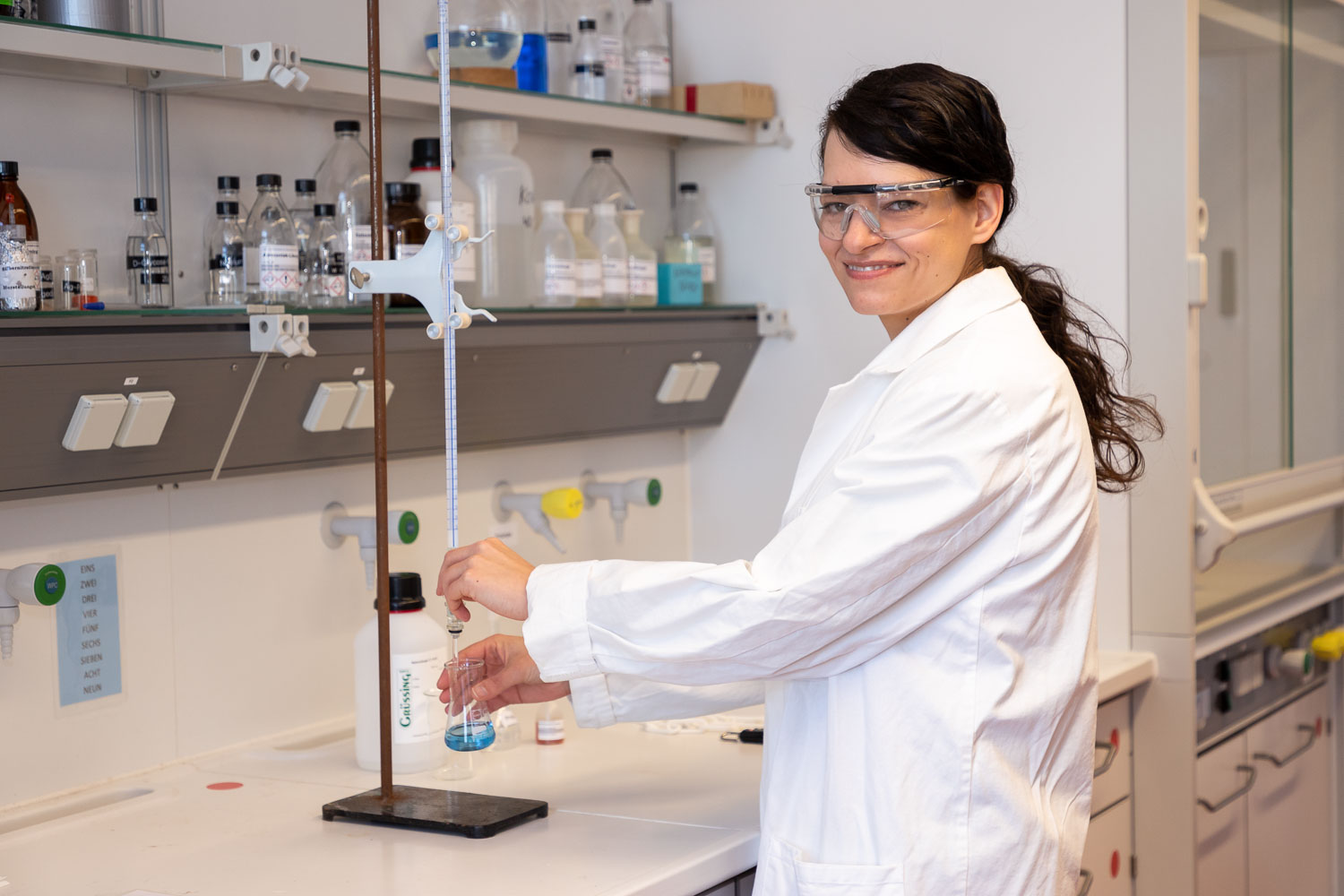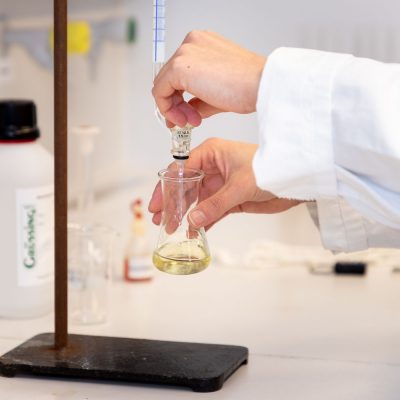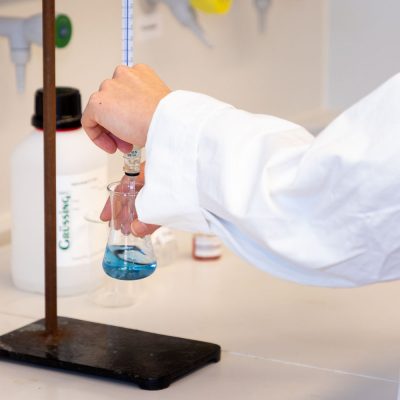Crime Scene Chemistry Lab Dr Luzie Semmler on creativity in chemistry lessons
Red and white barrier tape is stuck across the door of the chemistry laboratory in the Institute of didactics of natural sciences. A police seal marks the scene. Police cordon. No trespassing! What makes you flinch at first turns out to be the Escape Room of the Department of Chemistry and Didactics of Chemistry. Here, Dr Luzie Semmler shows a somewhat different laboratory class for general chemistry basics and explains to Bianca Loschinsky why creativity belongs in chemistry lessons.

Dr Luzie Semmler in the Escape Room of the Department of Chemistry and Didactics of Chemistry. Photo credits: Markus Hörster/TU Braunschweig
The story: The professor of chemistry, Prof. Dr. K. Tastrophe, has been kidnapped from her laboratory and there is no trace of her assistant either. The case can only be solved with the data on the professor’s laptop. However, the laptop is equipped with a self-destruct mode. To deactivate it, the professor has come up with something special: Anyone who wants access to her data must first overcome a sophisticated security system in one of her laboratories and uncover the password by cleverly combining information. However, the investigating task forces have reached their limits. The security system consists of chemical puzzles that can only be solved with the appropriate knowledge.
And now the students come into play: the police depend on their help. The Bachelor students are supposed to overcome the security system and find out what happened to the professor. To do this, they have to solve a few puzzles in the professor’s not-so-tidy laboratory room in order to decipher the decisive solution word. What is needed is the knowledge from the introductory module Chemistry and its Mediation. Dr Luzie Semmler has thus created a place where students can apply chemical knowledge with a playful approach and try out different solutions.
That is why we wanted to know from the scientist:
Is the Escape Room also something for chemistry lessons at school?
There are now various Escape Rooms that are intended for chemistry lessons. The one I have set up at the institute is too extensive for school lessons. Our Escape Room is rather something for an extracurricular place of learning and would therefore have a different appeal than a laboratory in school. In principle, however, you can adopt the principle and certainly some of our puzzles. There are also sets that contain different codes and websites that you can use. Add to that a box with a lock and you have the basics to set up a small Escape Room for students. Most Escape Rooms are designed for a school lesson, i.e. 45 minutes, in which the students are supposed to develop ideas and experiment. Usually, previously acquired knowledge is applied. After a teaching unit, teachers can use the Escape Room to incorporate a playful application of knowledge and skills. It is a good method to get academically weaker students excited about the topics and to arouse their interest.
- Photo credits: Markus Hörster/TU Braunschweig
- Photo credits: Markus Hörster/TU Braunschweig
Is there enough room for creativity in German schools?
The biggest hurdle is the time pressure in class, i.e. that teachers have to teach certain content in a certain amount of time. In the natural sciences, many topics build on each other and also become complex quite quickly. Therefore, there is often not enough time to leave room for the students to develop creatively, to develop their own ideas, to try them out and to really get to grips with them. For this, you also have to create a certain environment and atmosphere.
Another obstacle to integrating creativity into the regular classroom is the focus on performance and output. This quickly becomes noticeable with the pupils, but also with the first-year university students. The question is quickly asked: So what do I have to learn for the exam? We have to get away from this way of thinking if we want to stimulate and promote creativity. The focus should not be on the product, the exam or the test, but on how the process works, because that is where creativity actually takes place.
Creativity already takes place in clubs or learning workshops. But of course only selected pupils are addressed there. And mostly the better-performing ones, who often already have an interest in science anyway. The approaches there are good. Now we have to see how we can incorporate parts of it into the regular lessons.
Are other countries already further along in this respect?
The Scandinavian countries are often referred to when it comes to progressive teaching. The school concept is based on project work, among other things. This is a completely different system, which of course cannot be completely transferred to our school system in Germany. But there are schools that are trying out approaches and achieving success with them.
Excitingly, the next PISA survey will include creative thinking as a competence. I am very curious about the results. The criterion “problem-solving skills” from the PISA study can also be used here, because these are closely linked to creativity. Here it was shown that the Asian countries are very far ahead. In my research, I made a lot of reference to Great Britain. As early as 1999, a committee specially commissioned by the government formulated in a publication what creativity actually is and how it can be integrated and implemented in schools.
In the meantime, there is also an awareness in Germany that creativity is a key competence that must also be promoted in the STEM subjects. That’s where I focus my research and try to find ways.
STEM subjects are not among the most popular subjects for many pupils. What can teachers do about this?
The fact that the subjects are unpopular, especially in chemistry, has to do with the fact that the topics build on each other and quickly become quite complex. If you don’t keep up at the beginning, it becomes more and more difficult. That’s why it’s important to encourage interest early on, preferably in kindergarten. There, simple scientific phenomena can be dealt with through experiments, for example dissolving sugar in water. I believe that experiments are one of the great strengths of the natural sciences in awakening interest and motivation.
What are further ways to inspire enthusiasm about the lessons?
It is also very important to tie in with the students’ world. This has actually been taken into account in lessons for a long time: Everyday phenomena that the students can connect to and bring in their experiences. In addition, they should see a benefit in it themselves, otherwise it is too abstract and they cannot classify it.
One method is inquiry-based learning. The focus is on a scientific phenomenon that is presented to the pupils. They are then asked to develop a question and consider how they can investigate this question experimentally in order to draw conclusions and also reflect on this process. Then we are back to creativity! Because all of this also takes place in the creative process. This method is not new, you just have to use it and make sure that you take all the students with you. Learning aids and differentiation offers are important, because otherwise you can quickly overtax academically weaker pupils.

Dr Luzie Semmler researches creativity in chemistry teaching. Photo credits: Markus Hörster/TU Braunschweig
Chemistry lessons are not necessarily associated with creativity. Why is it nevertheless necessary in this subject?
Creativity has an interdisciplinary meaning. The global challenges we are currently facing – climate change, renewable energies – are scientific challenges. And they need creative and innovative approaches. There have to be people who develop solutions that we haven’t tried before, who try them out and see if they lead to the desired result. This is something that should be taught in all natural sciences at school. There are also scientific processes behind technical and medical innovations.
In the natural sciences, there is the scientific process of knowledge. This is exactly what I have already described: finding a problem, formulating hypotheses about it and thinking about how to approach, plan, carry out and evaluate the experiment, and finally present and reflect on it. That’s exactly what you have to do in school to generate knowledge and skills in the students that they can apply to such new situations.
These processes are also needed in everyday life. A simple example: The bicycle is rusting. What do I do to remove the rust from the bike and how do I prevent the bike from rusting again afterwards? These are scientific phenomena and problems that every young person faces, and they can be taught well in class.
I can continue this example. My bike gets a flat tyre while I’m on my way somewhere. But I don’t have any tools with me. How do I fix the tyre? The ability to transfer knowledge to the new situation must be learned and practised. You need this for all the scientific challenges we encounter in life.
How should the teaching of the future be designed?
I think we have to completely rethink. We already had our current structures in the school system 100 years ago. Schools have to become much more open and take into account the individual abilities and prerequisites of the students and allow as many paths as possible. This rethinking also has a lot to do with the role of the teacher. You are no longer just a mediator of knowledge. The focus must be on how to deal with the information and how to apply the knowledge and transfer it to new situations. It is not about writing the best possible paper at the end, but about looking at how the learning process works for the students.
To do this, the structure of the subject lessons should be broken up. This has already been implemented in comprehensive schools with science lessons. And the pupils should be given more responsibility and be allowed to work more independently. We could go a bit further and restructure the core curricula. In my opinion, we need a complete rethinking of the entire school system in order to adequately promote all these competences that will become important in the future. It’s not just creativity; it’s also preparation for the digitalised world.
What sparked your own interest in chemistry?
It actually came very late. I always liked chemistry and was not a bad student. During the upper secondary level, the teacher encouraged me so much that I had the impression I was quite good at the subject. At some point it was clear to me that I wanted to study teaching, but I didn’t know which subjects. German was always clear to me. I was unsure about the second subject. My chemistry teacher thought I could do it and gave me positive encouragement. However, my interest was only really awakened at the end of my studies when I was asked whether I could imagine doing a doctorate. That’s when I was hooked on the topic of “creativity”!


